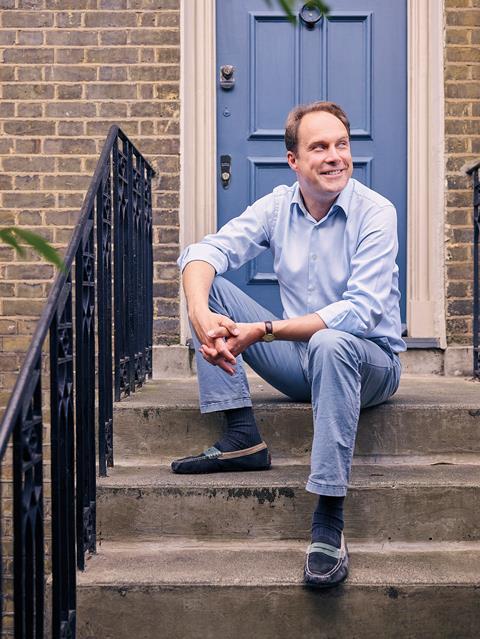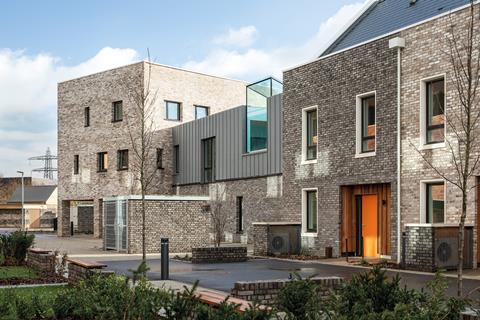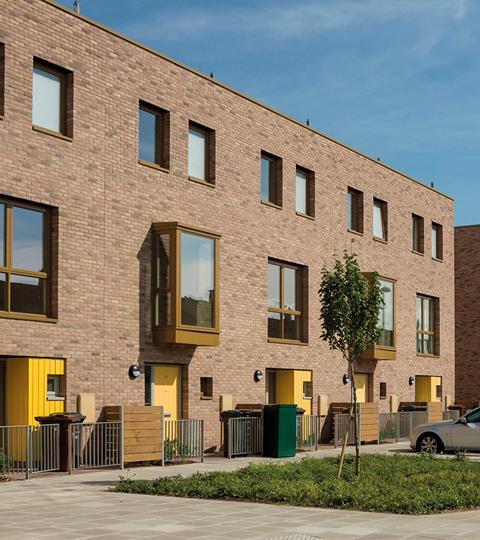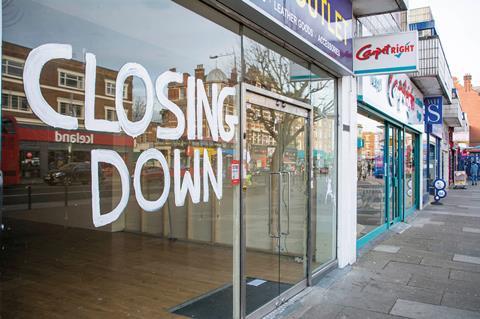There are few topics more controversial than planning reform and placemaking and few people more passionate about them than Nicholas Boys Smith, chair of the new Office for Place. He talks to Joey Gardiner about the governmentŌĆÖs intentions and how they square with his beauty agenda. Portrait photographs by Tom Campbell

Last month the housing secretary Robert Jenrick launched a new housing design body and reforms to the national planning policy intended to put the concept of beauty at the heart of the system. The man asked to chair the new Office for Place is the person associated more than any other individual with the governmentŌĆÖs agenda to improve the design of new homes and places: Nicholas Boys Smith.
The founder of campaigning charity Create Streets and, more recently, chair of the governmentŌĆÖs ║├╔½Ž╚╔·TV Better, ║├╔½Ž╚╔·TV Beautiful Commission, Boys Smith has spent more than a decade seeking to persuade planners, policy-makers, politicians and the industry that the houses we build can be ŌĆō and need to be ŌĆō so much better. An advocate for a ŌĆ£gentle densityŌĆØ approach to development and the use of design coding, he is, according to the Bartlett Real Estate InstituteŌĆÖs Yolande Barnes, quite simply a ŌĆ£man on a missionŌĆØ.
Speaking at the launch, Boys Smith began by hailing the ŌĆ£near-universal supportŌĆØ which greeted Living with Beauty, the final report of the commission. The 180-page document offered a detailed prescription for creating new places by bringing in trees and nature and developing according to ŌĆ£provably popularŌĆØ codes. While it wasnŌĆÖt quite a consensus ŌĆō former Redrow chief executive John Tutte was sharply critical ŌĆō it undoubtedly did garner much praise.
Some incredibly clear themes came through consistently during the beauty report, particularly the sense that communities are powerless in the face of big developers. People donŌĆÖt want the same homes built in Surrey as in Yorkshire or Berkshire
Nicholas Boys Smith
But the same cannot be said of the governmentŌĆÖs wider reforms of the planning system, of which these are part. Indeed, they are so divisive that they apparently helped to overturn a 16,000-seat Conservative majority at the Chesham and Amersham by-election in June. The government says that it wants to create a more predictable, ŌĆ£rules-basedŌĆØ planning system, while critics say the changes will take power away from local people.
What is less known is that Boys Smith, a supporter of the broader reforms, is himself a former special adviser to Conservative social security secretary Peter Lilley and a former Tory parliamentary candidate at the 2001 election. Some critics even see his ŌĆ£beauty agendaŌĆØ as part of a government smokescreen designed to get radical deregulation of planning past restive backbenchers and the wider public.
Boys Smith spoke exclusively to ║├╔½Ž╚╔·TV magazine and the Housing Today website about what this monthŌĆÖs changes to permitted development rights mean for the industry, what he thinks of the wider reforms, and why beauty is no smokescreen.
Road to Damascus
Westminster School and University of Cambridge-educated Boys Smith can trace his professional interest in urban design back to a specific moment. It was 10 years ago, on a trip to B&Q to buy pot plants, that he drove past an estate being demolished near his home in Southwark, south-east London. Looking at the plans to replace the flattened buildings, his immediate reaction was: ŌĆ£Well, I wouldnŌĆÖt want to live there.ŌĆØ
Wondering why on earth such development was being proposed, he started researching the topic, around his then day job as a consultant in financial services. He even asked one of the designers behind it some simple questions over the rationale. ŌĆ£It wasnŌĆÖt only that the guy couldnŌĆÖt answer,ŌĆØ Boys Smith says. ŌĆ£He obviously thought I was a bit naive asking such simplistic questions.ŌĆØ

Spurred on by his wife, who told him that he was becoming an urbanism ŌĆ£boreŌĆØ, he shared a draft of his own thinking on the topic with a friend, whose response ŌĆō ŌĆ£You lucky bastard, youŌĆÖve just found what youŌĆÖre going to do for the rest of your lifeŌĆØ ŌĆō inspired him to change career. The essay became the founding paper of Create Streets, the organisation that helped to turn him into undoubtedly the most politically influential thinker on placemaking in England.
Eloquent and very persuasive, the one-time McKinsey management consultant is no mere dry statistician, peppering his ŌĆ£beauty commissionŌĆØ report with musings of moral philosophers and describing his new role as helping to ŌĆ£make places where the body can prosper and the soul can singŌĆØ.
Boys SmithŌĆÖs core argument is that patterns of development should be based around what people genuinely want and value. And that if the planning system and the industry actually listened to this, they would see opposition to development reduce.
Gentle density
But there is a contradiction here. His beauty commission report recommended development at what he called ŌĆ£gentle densityŌĆØ, which means neither rows of semi-detached houses on the one hand nor gleaming towers on the other but instead terraces or mansion blocks based on traditional street patterns. This is despite the evidence that detached homes are seen as most desirable by the public.
Boys Smith does not deny this. ŌĆ£Like the vast majority of people in all countries,ŌĆØ Boys Smith admitted at the launch event, the British people ŌĆ£seek the joys of the garden suburb [ŌĆ”] People want space.ŌĆØ

He explains this apparent contradiction by stressing that not only are there a whole host of sustainability, health and land-take benefits to developing more densely, there is also a difference between the detached homes that people overwhelmingly say they want in surveys and the denser homes they actually value the most when parting with their cash to buy a property ŌĆō their so-called ŌĆ£revealed preferencesŌĆØ.
In other words, when people are forced to make a real choice of somewhere to live, they have to address the tension between the desire for space and the need for proximity to work, friends and services granted by denser urban forms. ŌĆ£When you look at the actual pricing data, then you find that areas at higher density than detached housing [are] higher value,ŌĆØ he says.
This is not Cabe 2
This kind of gentle density is, Boys Smith maintains, currently driven out of developments by a combination of the business models of developers, the box-ticking of planners and the stipulations of highways engineers. Replacing that, his vision is of communities ŌĆ£asking for beautyŌĆØ by drawing up local design codes which enforce delivery of ŌĆ£provably popularŌĆØ development types, alongside planning regulations that give communities the power to ŌĆ£refuse uglinessŌĆØ where they find it.
Last monthŌĆÖs launch, then, marked the first move towards this new system, with the settingŌĆæup of Boys SmithŌĆÖs all-new Office for Place. It is to be tasked with supporting the development of local design codes, and publishing research and best practice on housing design (see ŌĆ£The Office for PlaceŌĆØ, below, for details).
The Office for Place
The Office for Place is to be set up as a separate office within the housing ministry, with officials and two outside appointments ŌĆō initially fewer than a dozen staff in total ŌĆō reporting to the departmentŌĆÖs chief planner, Joanna Averley. Boys Smith has been given an independent, unsalaried role as chair of the advisory board designed to guide the setting-up of the new office, reporting to housing secretary Robert Jenrick.
Boys Smith says the body will have five functions: conducting research into what makes great places; supporting and (probably) accrediting the creation of local design codes; training local government officials and others to implement the agenda; celebrating and sharing best practice; and advising the government on policy. Initially, he says, the clear focus will be on the first two of those ŌĆō research and the creation of local design codes.
Boys Smith says the purpose of the research would be on work measuring and understanding what people like, in order to give public officials the confidence to work with neighbourhoods, rather than see them as obstructions ŌĆ£to be got roundŌĆØ.

On local design codes, the focus will be less on acting as an adviser to individual local authorities and developers on drawing up codes, and more on pointing them towards guidance ŌĆō such as the National Model Design Code ŌĆō that is already out there. Crucially, the Office for Place is also likely to have a role accrediting the local codes produced, and drawing up a process by which that happens. ŌĆ£We havenŌĆÖt made a definite decision we will [take that role],ŌĆØ he says, ŌĆ£but I think itŌĆÖs highly probable.ŌĆØ
In general, he says, ŌĆ£where possible we should be encouraging conversations rather than coming in and saying we know the answerŌĆØ.
Boys Smith also intends that the body be involved in the piloting of new approaches, and eventually it would also advise on wider questions, such as the role of local authority chief planners or county council heads of highways. ŌĆ£For example, might street trees be something that people in local councils should be targeted on? Or metrics for air quality? WeŌĆÖre starting to think through some of those questions.ŌĆØ
Ultimately, he says, the plan is for the Office for Place to become a fully independent body. However, the exact form of the body, and whether or not it would have statutory powers, is still under discussion with the Cabinet Office. Boys Smith does not want it to become simply a repeat of Cabe, the design quango culled by the coalition government in 2011.
ŌĆ£The Office for Place is not Cabe 2,ŌĆØ he says. ŌĆ£WeŌĆÖre at a different point. ItŌĆÖs not set up to be Cabe; itŌĆÖs set up to meet the needs we now have.ŌĆØ
Alongside the launch, the government also set out changes to planning policy via the National Planning Policy Framework (NPPF) which make achieving ŌĆ£beautiful [ŌĆ”] placesŌĆØ part of the core mission of the planning system for the first time. There is also a rewriting of the manual for streets guidance for highways engineers under way. This is seen as essential, given their role in blocking traditional street patterns and discouraging the planting of trees.
But isnŌĆÖt the brief for the body ŌĆō to support local communities in delivering good design and disseminate best practice for how to do it ŌĆō uncannily similar to that of Cabe, the building design body that was culled in David CameronŌĆÖs 2011 bonfire of the quangos? Not so, Boys Smith says. ŌĆ£The Office for Place is not Cabe 2,ŌĆØ he says, adding that the ŌĆ£world has moved onŌĆØ since that body ŌĆō which pioneered the use of design review but also undertook research and trumpeted good practice ŌĆō was abolished as a government agency. ŌĆ£Things Cabe was not able to do are now doable.
ŌĆ£The ease with which you can do some of the research is increasing, and the opportunities for broad digital engagement have been absolutely revolutionised. WeŌĆÖre at a different point. ItŌĆÖs not set up to be Cabe; itŌĆÖs set up to meet the needs we now have.ŌĆØ
ŌĆśP┤ŪĘ╔▒░∙▒¶▒▓§▓§ŌĆÖ
Of course, Boys SmithŌĆÖs focus on gentle density is an implicit rejection of the vast majority of what housebuilders build, and it is unsurprising, then, that his original report prompted sharp criticism from Redrow and others of its ŌĆ£narrowŌĆØ focus.
But the government is not shying away from this tension ŌĆō anything but. Jenrick was explicit at the launch event that the beauty agenda is in part designed to give local people ŌĆ£the wherewithal to stand up to the volume housebuildersŌĆØ on matters of design. The prescription stresses more community control to reflect local vernaculars, and a rejection of firms being allowed to roll out uniform house types across the country.
While Boys SmithŌĆÖs rhetoric is more measured than JenrickŌĆÖs, he says little to suggest that the anti-volume builder comments are just a political stance. Smaller developers need to be encouraged, he says, with the market ŌĆ£oddly concentratedŌĆØ into a few very large players. This means that builders ŌĆ£donŌĆÖt face the level of competition they shouldŌĆØ.
He adds: ŌĆ£Some incredibly clear themes came through consistently during the beauty report, particularly the sense that communities are powerless in the face of big developers. People donŌĆÖt want the same homes built in Surrey as in Yorkshire or Berkshire.ŌĆØ
Planning reform
It is impossible, however, to wholly separate these tweaks to the NPPF ŌĆō and the setting-up of the Office for Place ŌĆō from the deeper reforms of the planning system envisaged by the government, which include the adoption of a zonal system and the scrapping of section 106. Jenrick wrote in last summerŌĆÖs white paper that the reforms were designed to ŌĆ£place a higher regard on quality, design and local vernacularŌĆØ than ever before, with design codes being tasked with much of the heavy lifting to ensure that proposed ŌĆ£growthŌĆØ zones are built out according to communitiesŌĆÖ desires.
However, Boys Smith, who was part of a tight clique brought in to advise ministers on the white paper, declines both to reveal the long-awaited details of how these reforms will be brought forward ŌĆō a government response to the white paper is promised in the autumn ahead of legislation ŌĆō or shed much light on what the reforms will do to embed the ŌĆ£beautyŌĆØ agenda.
ŌĆ£Clearly the direction of travel in the Planning Bill is more focused on shorter and more visual local plans, and that will only make this [beauty] agenda more relevant,ŌĆØ he says. ŌĆ£But the detail goes beyond what I can say ŌĆō I havenŌĆÖt read a draft of the bill.ŌĆØ
Controversy
Despite the controversy attached to the wider reforms, which Labour has dubbed a developersŌĆÖ charter and other critics say will reduce democratic involvement in planning, Boys Smith is adamant that they are essential to improve the quality of new places. What others view as removing democratic involvement ŌĆō proposals include limiting the time frame for creating local plans, setting housing numbers from Whitehall, and removing the ability of local communities to stop applications being approved in allocated ŌĆ£growthŌĆØ areas ŌĆō he sees as delivering ŌĆ£planning certaintyŌĆØ to developers.
The idea is that increased certainty will reduce the barrier to entry for new players posed by the current planning system, thereby increasing competition and forcing developers to up their game on design.
ŌĆ£Ultimately, creating more of the right places is very hard to do without some level of change to the whole system,ŌĆØ he says, adding that the government is ŌĆ£genuineŌĆØ and ŌĆ£passionateŌĆØ about the beauty agenda, and ŌĆ£thinking hard about how we make better placesŌĆØ.

He insists that the governmentŌĆÖs proposed reforms are not deregulatory, but instead are about ŌĆ£better regulationŌĆØ. He adds: ŌĆ£Currently we have nationalised development rights, but are unclear about how that nationalisation will be implemented.
ŌĆ£It is right to be unclear and flexible for unclear or complex situations ŌĆō a system that can be case-specific ŌĆō but it is not helpful to have a system that is case-specific for the ŌĆśgood ordinaryŌĆÖ, because thatŌĆÖs just what stops people doing things, which is whatŌĆÖs happening. And it is not good that people are uncertain or fearful about what development will mean. If we can give people more confidence about the nature of development, that must be a good thing.ŌĆØ
Seventeen percent of shops are empty now. when youŌĆÖve got a housing challenge, it is indefensible to be supporting a system that is allowing that high a level of vacant use
Nicholas Boys Smith
But does he worry that being tied in with the controversy over the wider reforms could undermine the rollout of the beauty agenda with which he is specifically tasked? ŌĆ£IŌĆÖm very mindful there are risks in changing how we do things. But you have got to take those risks, you have got to go for it, because I think the prize is great.
ŌĆ£Not only have we not been creating enough homes, we have not been creating good enough places. I hope we can continue to make it as non-controversial as possible, but actually a bit of controversy forces you to have the conversation.ŌĆØ
For many government critics, the continued expansion of permitted development ŌĆō which has allowed buildings such as Terminus House in Harlow and windowless industrial units in Watford to be converted to housing without planning permission ŌĆō undermines any claim that it can have to be on the side of quality, or design, or ŌĆ£beautyŌĆØ.

Despite a government-commissioned review of permitted development finding last year that it delivered on average worse-quality housing over a wide range of measurable criteria, ministers have subsequently brought in a range of new rights, allowing the conversion of almost all townŌĆæcentre properties to housing, as well as the demolition and rebuilding of vacant units ŌĆō albeit with some new safeguards.
Boys SmithŌĆÖs beauty commission report criticised the rollout of permitted development, but he now seems to have changed his mind on it ŌĆō given the light and space standards subsequently brought in ŌĆō and appears to see no contradiction between it and the beauty agenda. His view appears to be that, as change of use under permitted development does not allow change in external appearance, it is neutral in ŌĆ£beautyŌĆØ terms, but by allowing the reuse of existing buildings, permitted development promotes the sustainable adaption of towns and cities.
ŌĆ£The idea that itŌĆÖs possible to micromanage what happens to every shop is, I think, for the birds, and people have to realise you have got to have the confidence to let high streets and towns and cities evolve their use over time,ŌĆØ he says. ŌĆ£It doesnŌĆÖt mean you abandon all regulation or quality control of whatŌĆÖs expected over minimum homes standards or how it interacts with the public realm, but it doesnŌĆÖt mean you try to control every change of use, because I donŌĆÖt think that works.
ŌĆ£I think itŌĆÖs 17% of shops that are empty now. When youŌĆÖve got a housing challenge, it is indefensible to be supporting a system that is allowing that high a level of vacant use.ŌĆØ
Permitted development
Boys SmithŌĆÖs support for permitted development is likely to raise eyebrows among many, particularly in the design community, who have so far been supportive of the beauty agenda but are violently opposed to PD. It may even fuel suspicions that the former Conservative party prospective parliamentary candidate for Walthamstow is actually a political appointee, and that the beauty reforms are a smokescreen for the broader agenda around planning.
It is a charge that he denies vehemently. ŌĆ£This is not a smokescreen for carpeting over the country with boxes dumped in fields. I donŌĆÖt think anyone who spends any time with me could think otherwise,ŌĆØ he says.

ŌĆ£Create Streets has spent the last seven or eight years doing research into what people like. WeŌĆÖve worked with dozens of neighbourhood and community groups across the country. If someone wants to say that [IŌĆÖm a political appointee] they can. [But] I donŌĆÖt think itŌĆÖs a fair or legitimate summary of the work that Create Streets has done.
ŌĆ£If you come at this from a very partisan view ŌĆō if you think all state regulation is bad, we canŌĆÖt really help you there. And, if you think that talking about anything other than social housing is a middle-class distraction, we canŌĆÖt help you there either.
ŌĆ£So, for people with quite extreme political views, weŌĆÖre probably not very helpful. But for the broad mass of people that want to create popular, lovable places with some heart, I think weŌĆÖve got something to say.ŌĆØ
There is no doubt that Boys Smith is committed to improving the way that most houses are built and designed in this country, and that a shake-up of the many rules ŌĆō such as highways codes ŌĆō and business models to improve what he describes as the ŌĆ£good ordinaryŌĆØ could do a huge service to both the country and, in the long term, the industry. Boys Smith is a genuine deep thinker on these issues and certainly not just a political place-man.
But the jury is still out on whether his growing association with more controversial ideas on permitted development and in the white paper ŌĆō of which he is one of the most eloquent advocates ŌĆō will ultimately undermine the coalition of support that appeared to have formed around the beauty agenda.


























No comments yet